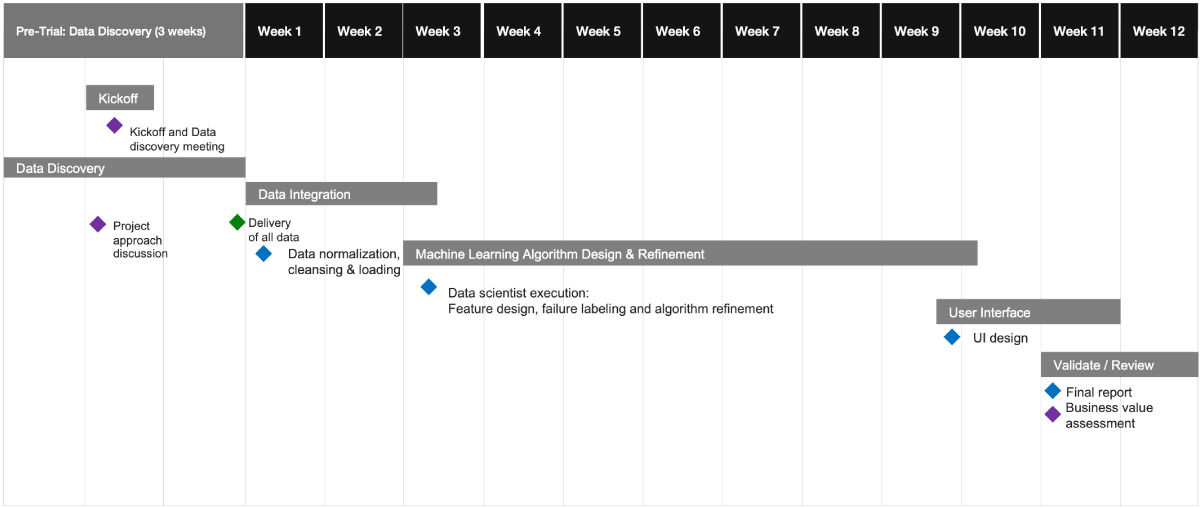- AI Software
- C3 AI Applications
- C3 AI Applications Overview
- C3 AI Anti-Money Laundering
- C3 AI Cash Management
- C3 AI CRM
- C3 AI Decision Advantage
- C3 AI Demand Forecasting
- C3 AI Energy Management
- C3 AI ESG
- C3 AI Intelligence Analysis
- C3 AI Inventory Optimization
- C3 AI Process Optimization
- C3 AI Production Schedule Optimization
- C3 AI Property Appraisal
- C3 AI Readiness
- C3 AI Reliability
- C3 AI Smart Lending
- C3 AI Sourcing Optimization
- C3 AI Supply Network Risk
- C3 AI Turnaround Optimization
- C3 AI Platform
- C3 Generative AI
- Get Started with a C3 AI Pilot
- Industries
- Customers
- Resources
- Generative AI
- Generative AI for Business
- C3 Generative AI: How Is It Unique?
- Reimagining the Enterprise with AI
- What To Consider When Using Generative AI
- Why Generative AI Is ‘Like the Internet Circa 1996’
- Can Generative AI’s Hallucination Problem be Overcome?
- Transforming Healthcare Operations with Generative AI
- Data Avalanche to Strategic Advantage: Generative AI in Supply Chains
- Supply Chains for a Dangerous World: ‘Flexible, Resilient, Powered by AI’
- LLMs Pose Major Security Risks, Serving As ‘Attack Vectors’
- C3 Generative AI: Getting the Most Out of Enterprise Data
- The Key to Generative AI Adoption: ‘Trusted, Reliable, Safe Answers’
- Generative AI in Healthcare: The Opportunity for Medical Device Manufacturers
- Generative AI in Healthcare: The End of Administrative Burdens for Workers
- Generative AI for the Department of Defense: The Power of Instant Insights
- What is Enterprise AI?
- Machine Learning
- Introduction
- What is Machine Learning?
- Tuning a Machine Learning Model
- Evaluating Model Performance
- Runtimes and Compute Requirements
- Selecting the Right AI/ML Problems
- Best Practices in Prototyping
- Best Practices in Ongoing Operations
- Building a Strong Team
- About the Author
- References
- Download eBook
- All Resources
- C3 AI Live
- Publications
- Customer Viewpoints
- Blog
- Glossary
- Developer Portal
- Generative AI
- News
- Company
- Contact Us
- Introduction
- What is Machine Learning?
- Tuning a Machine Learning Model
- Evaluating Model Performance
- Runtimes and Compute Requirements
- Selecting the Right AI/ML Problems
- Best Practices in Prototyping
- Problem Scope and Timeframes
- Cross-Functional Teams
- Getting Started by Visualizing Data
- Common Prototyping Problem – Information Leakage
- Common Prototyping Problem – Bias
- Pressure-Test Model Results by Visualizing Them
- Model the Impact to the Business Process
- Model Interpretability Is Critical to Driving Adoption
- Ensuring Algorithm Robustness
- Planning for Risk Reviews and Audits
- Best Practices in Ongoing Operations
- Building a Strong Team
- About the Author
- References
- Download e-Book
- Machine Learning Glossary
Best Practices in Prototyping
When evaluating and scaling machine learning systems, managers are faced with constraints: people, technology, budget, and time. To profoundly impact the organization, managers must balance the need to enable data science experimentation with the realities that business value is usually only captured after models are deployed to production and integrated into business processes.
If the prototyping phase is mismanaged or cut short, immature models can succumb to real-world complexities and be rejected by business teams and end users. If the experimentation phase is allowed to drag on, the business burns through precious budget and wastes time on “science experiments.”
This chapter focuses on best practices for the prototyping phase: how to set it up for success, what to watch out for, and how to know when a model is good enough.
Problem Scope and Timeframes
Each organization will vary in its capacity to provide leeway for data science teams to identify solutions for complex business problems. However, it is universal that rapid demonstration of success and value generation is key to ongoing funding and resourcing of AI use cases.
In our ten years deploying AI systems at C3 AI, we have seen a common pattern across business teams. Most teams are interested in the capabilities of AI/ML and are looking to verify the potential for algorithms to demonstrate operationalizable business value, usually within 8 to 16 weeks or, at most, 24 weeks. Following this, business teams either decide to double-down and operationalize the AI capabilities, or move on to different problems.
In order to demonstrate the value of AI/ML, and to accelerate adoption and ensure future investments, we recommend carefully managing the scope of the problem based on two criteria:
- Reduce the scope of initial work to create boundaries around the problem so that it can be solved in a short period of time, usually no more than 8 to 16 weeks, while at the same time ensuring sufficient complexity to convince decision makers of the algorithms’ benefits.
- Ensure that if the initial work is successful, it can be rapidly transitioned into production to unlock significant economic value.
The following figure demonstrates a typical timeline for a small team to start and complete the experimentation phase of AI use case development.

Figure 27: Typical timeframe for an AI/ML prototype
Note that managers should ensure that prototype efforts are conducted with a view towards a rapid transition to production with minimal additional effort, and the corresponding ability to capture significant economic value.
A good rule of thumb is to seek to operationalize into production an AI/ML prototype within six months of the prototype effort’s start. This focus on value and time to production can greatly accelerate the organization’s excitement and interest around AI/ML and its ability to scale up its AI digital transformation efforts.
